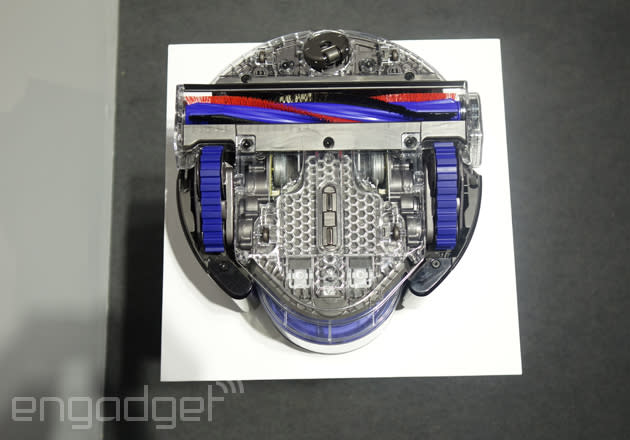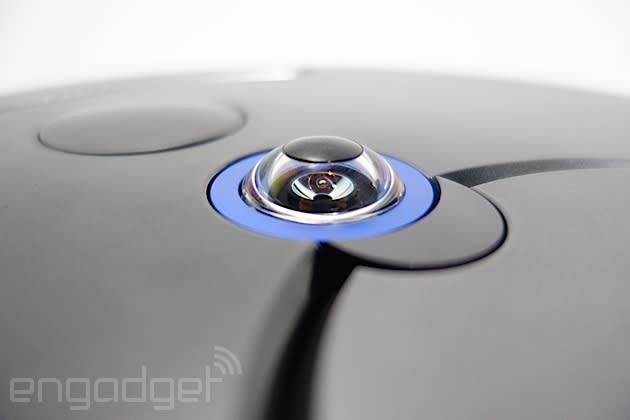Why Dyson's robot vacuum took 16 years, and why it's headed to Japan first

Dyson almost launched a robot vacuum. Back in 2001, after three years in development. Its first effort, shown to the British public in London looked nothing (and we mean nothing) like the eventual 360 Eye unveiled today. Sixteen years is a long time in tech. The DC06, as it was called, never made it past home-trial stages in 2012 -- apparently too pricey and heavy. Between then and now, technology got better. A lot better. At the Tokyo launch of its new robot vacuum, Sir James Dyson himself, told us how it all came together, and why it's not his native UK, but Japan, that'll get to buy it first.
At the start of its 16-year development, Dyson's early robot vacuum model was powered by old, heavy Ni-Cad batteries and "old motion-detection technology sensors." Dyson explained: "We ended up with 85 different sensors and big, old motors. We got very close -- spent a lot of money on it -- but then we decided it just wasn't good enough."

"And we had better ideas," he added. "Engineers are dreadful -- they always have better ideas. I don't mind that -- I think it's quite a good habit." The point being, he continues, that his company spent a lot of money in 16 years "to make the right product."
"We got very close -- spent a lot of money on it -- but then we decided it just wasn't good enough."
Dyson added that the team soon realized that vision sensors geared to measure a room, to triangulate location were the way forward. "This technology has a lot of mileage in it -- and we're just at the beginning," he said. The team paired it with its existing, but still very recent, digital motor (the same one used in Dyson's stick vacuums) -- a motor that balanced suction power with a small footprint and weight.

If you're basing your impressions of Dyson's new vacuum on those press images, we have some very good news: It might look huge in the renders, but it's pleasingly petite in real life. Notably taller, but not like the rice-cooker-on-wheels we feared from those shots. Dyson being Dyson, there's a reasoning:
"If you think about chairs, [large-diameter vacuums] can't get between those, between wardrobe and door gaps," Dyson said. "Other robot vacuums may look bigger, but you need to consider [Dyson's] full-width brush bar." The smaller-sized bot's brush covers the width of the machine, but it's also handily contained by a plastic barrier. From Dyson: "If you make a really big brush bar, you lose the suction to pull it in. This size is optimal for the power we've got ... and it can go into [smaller] spaces. You don't sacrifice anything."

The second (and it's the almost literal jewel) of Dyson's robot vacuum is that eye: a panoramic lens that aims itself at a 45-degree angle, getting a view of the room, of your house, and taking what it sees into the center and reflecting it downward. "It's interpreting what it's seeing and calculating triangulations at 30 times a second," Dyson said. And it's been designed to ensure it can find its way back home easier. "The first thing it does is turn around to view the dock, all while filming the room," he explained. "In those seconds, it knows the room and where the dock is."
Dyson adds that it isn't specifically geared for hard flooring or carpet-- it's designed for everything, thus the tank-styled caterpillar treads. And that's coupled with that Dyson suction: "We have 100 times the suction power of the Roomba model." That's almost exactly the numbers shown from the company's tests comparing its model to one of iRobot's latest. Granted, it's Dyson doing the testing, but:

The 'bot can climb up to 15mm with those treads, but the combination of high-level suction and nylon bristles also makes it well-suited to Japan's tatami (rice straw) mats -- lots of nooks, but also relatively delicate fibers. Which is convenient, as the 360 Eye will be coming to Japan first, in the spring of 2015. And barring Dyson's love of launching things in (and having an excuse to visit) Japan, there's some solid reasoning for it. "The country adopts to new technology faster than anyone else," he said. "We're also 'Big in Japan' -- the largest vacuum brand in Japan, and this country is the largest market for robots." No arguments there.























